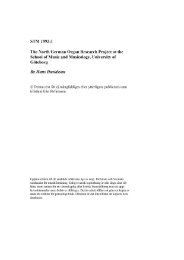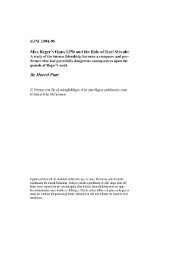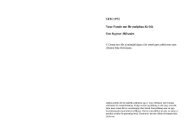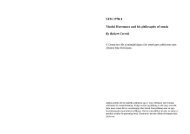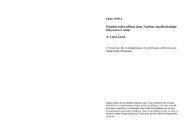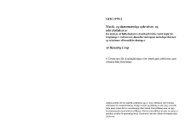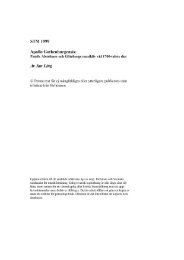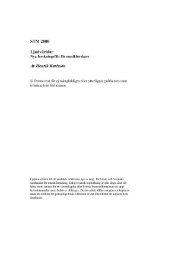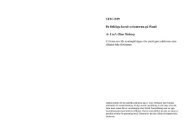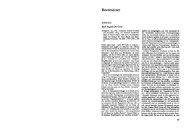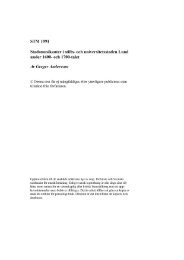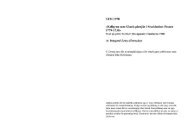Recensioner - Svenska samfundet för musikforskning
Recensioner - Svenska samfundet för musikforskning
Recensioner - Svenska samfundet för musikforskning
Create successful ePaper yourself
Turn your PDF publications into a flip-book with our unique Google optimized e-Paper software.
afraid to put in the painstaking leg-work. This he<br />
has certainly done. Indeed he is clearly a researcher<br />
who is now on intimate terms with his material.<br />
So although to some readers it may seem that<br />
the book’s focus on the Jew’s harp alone, to the<br />
exclusion of all other contemporaneous instrument<br />
types, is a narrow one, this is also in a sense<br />
one of its particular virtues. It is, at last, putting<br />
the musicological cart back behind the archaeological<br />
horse, and to good and timely effect. It<br />
seems appropriate to this reviewer that such pioneering<br />
work should be taking place once more<br />
within the interdisciplinary traditions of Nordic<br />
scholarship which, in the 1970s and 1980s, did<br />
so much both regionally and globally to foster<br />
music-archaeology’s early development.<br />
There are few interpretive conclusions in this<br />
book with which this reviewer finds himself in<br />
strong disagreement. There are, however, some<br />
curious absences. In an archaeological study, for<br />
example, some more detailed treatment of archaeologically-derived<br />
dates might be expected, in<br />
particular reviewing the evidence on which they<br />
have been based (for instance, the datable elements<br />
within the stratigraphic structure of the<br />
site, and an evaluation of their reliability). This<br />
would no doubt have been impractical for every<br />
catalogue entry, but surely appropriate to a selection<br />
of key dates. Similarly we hear little or nothing<br />
of the cultural contexts in which the<br />
instruments were found – and what other musical<br />
or sound-related activity may have been represented<br />
there (at Alvastra Kloster in Sweden to take<br />
just one example, he does not mention that there<br />
are, besides Jew’s harps [Catalogue nos. 98–101],<br />
several bone pipes and even parts of other instruments).<br />
The dialogue format of two chapters, set<br />
in the mouths of two fictitious researchers, is also<br />
unusual in a work of this kind, and has the unfortunate<br />
effect of leaving the reader wondering<br />
whose opinions are being expressed at any given<br />
moment, and to which of them the author himself<br />
subscribes.<br />
Having said that, given the constraints of<br />
time and budget which are inevitable in a doctoral<br />
programme, it is otherwise difficult to fault<br />
the work as a whole. The author’s written English<br />
is excellent. His knowledge of archaeological<br />
finds and the technologies that produced them is<br />
132<br />
<strong>Recensioner</strong><br />
clearly in his fingertips (he is evidently an instrument-maker<br />
as well as an archaeologist and musician).<br />
The Catalogue is a well-presented and<br />
impressive piece of original work, maintaining<br />
throughout a proper uniformity of treatment and<br />
a fullness of information which make it useful to<br />
consult. In addition to a portrait image, each<br />
entry includes details of source (country, region<br />
and site), present whereabouts (e.g. name of<br />
museum), date (if available) and site type (e.g.<br />
‘urban’); material and manufacture details;<br />
dimensions; author’s classification; brief comments<br />
(including context and stratigraphy, where<br />
available) and references. This establishes a new<br />
scientific standard within palaeo-organological<br />
indexing.<br />
This book, in short, is clearly going to be the<br />
reference work for any future research in these<br />
traditions, both in Europe and in the wider<br />
world, and an important reference-tool for organology<br />
(musical instrument studies) in general. It<br />
is a must-have for anyone interested in music as<br />
material culture.<br />
Graeme Lawson<br />
Liber scole virginis. En medeltida samling av Mariamusik<br />
i Lund (A Medieval Collection of Marian<br />
Music in Lund). Faksimilutgåva av LUB MH 14<br />
med inledning, transkription och kommentar.<br />
Lunds universitetsbibliotek, Lund 2003. (Skrifter<br />
utgivna av Universitetsbiblioteket i Lund, Ny<br />
följd 5.) 186 s., ISBN 91-7874-175-0<br />
Enstämmiga sånger till jungfru Maria finns i en<br />
av de medeltida handskrifter som <strong>för</strong>varas i<br />
svenska bibliotek: musikhandskriften nr 14 i<br />
Lunds universitetsbibliotek, den s.k. Liber scole<br />
virginis, ”Mariakörens” bok. Den är intressant<br />
genom sin inriktning och sin sammansättning av<br />
material från 1300- till 1500-talet. In<strong>för</strong> 900-årsminnet<br />
av Lunds ärkebiskopsdömes inrättande<br />
har en vacker kommenterad faksimileutgåva<br />
framställts där sju forskare har kommenterat utifrån<br />
sina olika synvinklar. Själva faksimildelen<br />
kan även studeras på Internet (http://laurentius.lub.lu.se).<br />
Editionen riktar sig till en bred läsekrets



